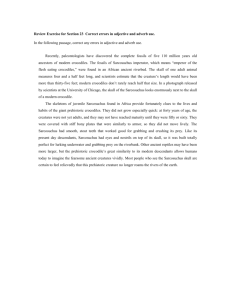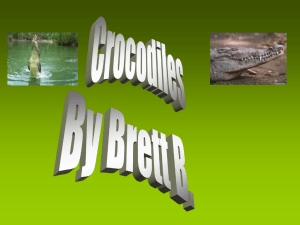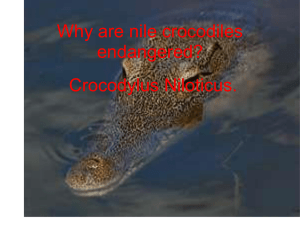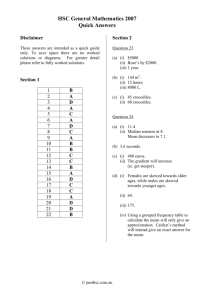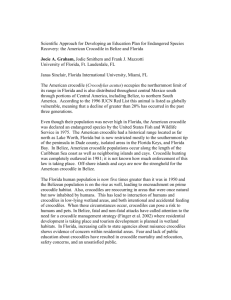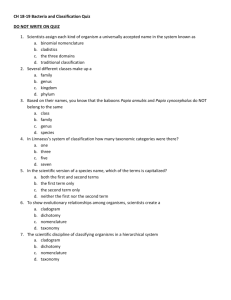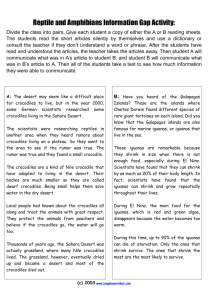Recommended Guidelines for the Captive Management of Crocodiles
advertisement
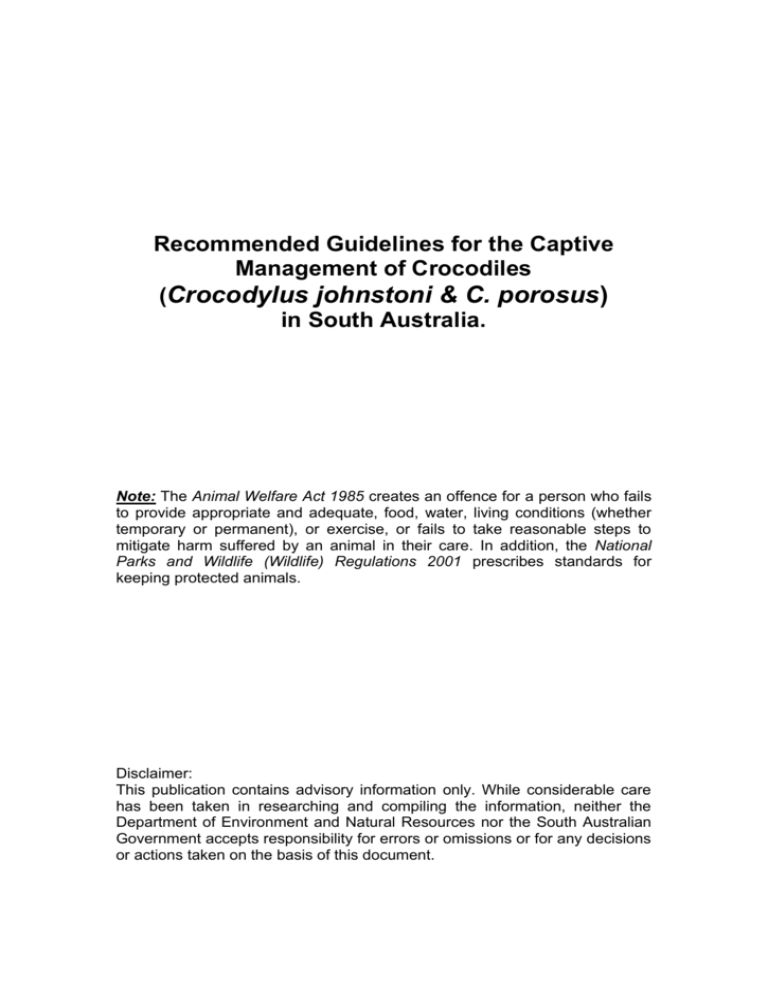
Recommended Guidelines for the Captive Management of Crocodiles (Crocodylus johnstoni & C. porosus) in South Australia. Note: The Animal Welfare Act 1985 creates an offence for a person who fails to provide appropriate and adequate, food, water, living conditions (whether temporary or permanent), or exercise, or fails to take reasonable steps to mitigate harm suffered by an animal in their care. In addition, the National Parks and Wildlife (Wildlife) Regulations 2001 prescribes standards for keeping protected animals. Disclaimer: This publication contains advisory information only. While considerable care has been taken in researching and compiling the information, neither the Department of Environment and Natural Resources nor the South Australian Government accepts responsibility for errors or omissions or for any decisions or actions taken on the basis of this document. CONTENTS PAGE 1. BACKGROUND INFORMATION 1 2. SCOPE 2 3. OBJECTIVES 2 4. GUIDELINE DETAILS 4.1 Manner of Housing 4.2 Spatial Requirements 4.3 Enclosure Construction 4.4 Substrate and Drainage 4.5 Weather Protection 4.6 Gates, Doors and Slides 4.7 Enclosure Furniture 4.8 Electrical and Other Equipment 4.9 Indoor Housing of Animals 4.10 Hygiene 4.11 Behavioural Enrichment 4.12 Diet and Feeding 4.13 Adult Diet 4.14 Juvenile Diet 4.15 Identification 4.16 Regular Health Checks 4.17 Carer and General Public Safety 4.18 Zoonotic Diseases 2 2 3 4 8 8 8 9 9 11 12 12 12 13 14 14 14 15 16 5. FURTHER INFORMATION 17 6. DEFINITIONS 18 ii NOTE: These guidelines are to be read in conjunction with the “General Guidelines for the Management of Protected Wildlife in Captivity in South Australia”. 1. BACKGROUND INFORMATION Crocodiles do not make good pets for the majority of people, however with suitable experience, the right equipment, enough space and resources to set up an appropriate enclosure, crocodiles can be rewarding to keep. A person should not acquire a crocodile unless they are capable of housing it comfortably and safely when it reaches its maximum size (see Table 1). Table 1: Lifespan and adult length of Australian crocodiles. Common Name Latin Name Maximum Adult Male Length (m) Maximum Adult Female Length (m) Lifespan (years) Australian Freshwater Crocodile Australian Saltwater Crocodile Crocodylus johnstoni 3 2 40+ Crocodylus porosus 6 4.2 70+ Saltwater Crocodiles are highly unsuited to captivity unless being held by professional zoological establishments or highly skilled private keepers with outstanding facilities. A person applying for a permit to keep Saltwater Crocodiles will be required to detail alternative care arrangements should a situation arise where they are no longer able to care for the animals. Freshwater Crocodiles can be kept more easily, however for the general person they are unsuitable as pets. An applicant must be in a stable financial position, have long-term facilities available, be physically capable of dealing with very strong and unpredictable animals, and have several years of experience with larger reptiles. Keeping a hatchling crocodile can be relatively easy, however they grow quickly and a persons‟ ability to keep a crocodile now may not be the same in a few years time. Crocodiles are long lived animals and the available information suggests that Freshwater Crocodiles can live to more than 40 years. There is enough reliable information from long term captive Saltwater Crocodiles to conclude that some individuals can reach at least 70 years of age. Keeping a crocodile is a long term commitment, and many people purchase a crocodile in the belief that they will be able to give it away once it grows too large. Future plans should be carefully considered before a decision is made to purchase a crocodile, as there are very few people who could accept large crocodiles and zoos are very unlikely to have space for unwanted pet animals. It is an offence under the National Parks and Wildlife Act 1972 to release unwanted crocodiles and therefore the only alternative for the animal if the owner is not able to keep it or find an alternative home for it is to have it euthanized. 1 Compared with many other animals, crocodiles grow rapidly to large adult sizes and you should plan for housing adult animals before acquiring a juvenile crocodile. Crocodiles will increase in length at least 20 to 30 times from hatchlings, and increase in weight by at least 1,000 times within 10 to 20 years. However growth rates can vary significantly between individuals and are dependant upon factors such as temperature, frequency of feeding, quality of food and social factors. Despite this variation, all crocodiles show a fairly typical growth pattern: initial growth rates are rapid, often for several years, but slowly begin to decline as the animal matures. 2. SCOPE These guidelines apply to members of the public that apply for and/or obtain a DENR a “permit to keep” crocodiles in captivity. These procedures do not apply to crocodiles held in; Zoological Institutions Approved Research Programs Veterinary Clinics Pet Shops 3. OBJECTIVES The objectives of these guidelines are to: Provide recommended guidelines which protect captive crocodile welfare; and Ensure a consistent State wide policy for the captive holding and care of crocodiles. 4. GUIDELINE DETAILS 4.1 Manner of Housing Appropriate housing is perhaps the most difficult part of keeping a crocodile and several factors need to be considered including the size of the enclosure, how to divide it into land and water areas, heating both water and air, and how to best keep the water clean. The long-term cost of housing a crocodile and the size of the area required will also need to be considered. The basic requirements for the housing and welfare of captive crocodiles are: a) Appropriate and sufficient food and water to sustain health and vitality; and b) Sufficient area to maintain well-being and to allow crocodiles to exhibit normal behaviour; and c) Protection from predation; and d) Protection from disease, including disease that can be exacerbated by poor management practices; and e) Protection from extremes of climate, particularly during certain phases of their lives; and f) Protection from pain, distress, suffering and injury. All crocodiles must be provided with enough space for comfortable movement on both land and in water. It is important to establish appropriate stocking 2 densities in an enclosure, as cramped housing of multiple animals will lead to undue aggressive behaviour and increased levels of injury and stress. Elevated stress levels in captive crocodiles can lead to poor growth and survival rates, disease, poor skin quality, and reproductive failure. The overall success of keeping crocodiles relies upon minimising stress by providing and maintaining high water quality, adequate temperatures, appropriate cover, high quality food and good hygiene. Crocodiles sharing an enclosure should be of a similar size to reduce bullying or fighting for territory. It is important to understand crocodile thermoregulatory requirements before designing an enclosure, as unlike birds and mammals crocodiles are unable to maintain a constant body temperature by physiological means, and instead maintain a preferred body temperature of approximately 30oC to 33oC by moving between warm and cool areas in their environment. Wild crocodiles warm up by basking in direct sunlight on land, and then cool down by moving into a shaded area, or back into the water. Conversely, at night crocodiles stay warm in the water as temperatures on the land drop. Successful crocodile housing requires that a "thermal gradient" is established in the enclosure, with a range of temperatures being made available from around 260C to 360C and enough space so that the animal can move between cooler and warmer areas. Crocodiles require fairly warm temperatures which must be maintained at all times, and both land and water heaters will be required. Regular inspection and evaluation of the enclosure must be undertaken to monitor security, hygiene and to detect potential housing problems. Enclosures should be designed so they can not be easily accessed by persons other than experienced handlers. 4.2 Spatial Requirements 1) Each animal must be provided with sufficient space to enable it to: a) Take exercise; and b) Be protected from undue dominance and conflict with the same or other species; and c) Be provided with its husbandry needs. Note: Estuarine crocodiles are extremely territorial and fights, particularly between adult males, can cause extreme stress, physical damage and sometimes death. Freshwater crocodiles are more gregarious and will co-exist in small groups. All crocodiles grow to be very large animals compared to many other reptile species. The urban myth that a crocodile will stay small if it is kept in a small 3 enclosure is totally incorrect. In a small enclosure a crocodile will continue to grow until its movement is eventually hindered, resulting in deformed limbs, snout and tail as the body tries to increase in size naturally. This is extremely cruel and results in a stunted and unhealthy animal with a seriously compromised lifespan. The recommendations given below are minimum size requirements in accordance with current industry best practice. However the actual number of animals that can be safely housed in any one enclosure can vary greatly depending on a number of factors. The minimum width and depth of an enclosure to house a single crocodile (of either species) should be 3 times the animal's total length, with pond surface area making up around half of the enclosure and at least 0.6 metres deep. Larger sizes are preferable however, as crocodiles that are kept in small enclosures where movement is restricted will soon become lethargic and obese, increasing their susceptibility to cardiac and other diseases. With the exception of enclosures housing hatchlings or juvenile animals, enclosures should be constructed based upon the maximum size the animals will attain. The enclosure size must increase for each additional animal that will be housed. As a general rule, area should be increased 30% (20% more water and 10% more land) per additional animal. 4.3 Enclosure Construction There are a number of ways of housing large crocodiles, however it is important to ensure that the enclosure can be cleaned easily, the water drained rapidly, and maintenance kept simple. Crocodile enclosures should be designed to ensure that ongoing maintenance requirements are considered. As a general rule, if work can be performed from outside a crocodile enclosure it should be. If this can not be achieved then the crocodile or crocodiles should be isolated in a separate section of the enclosure. Isolation will usually require built-in features such as gates, fencing or other barriers. Note: The construction of larger enclosures may require local Council approval to meet pool fencing standards and other requirements. Crocodiles are semi-aquatic animals and therefore provision needs to be made for both water and land areas when designing an enclosure. Maintenance requirements will vary greatly depending on the overall size and design of the enclosure, the size and number of crocodiles housed and the enclosure substrate that is used. It is important to balance the frequency of cleaning with minimising stress to the animals. The most important aspect of cleaning is the water and pond area, as this is where most bacterial contamination and disease generally originate. 4 Hatchling and juvenile crocodiles can be maintained in glass aquariums or terrariums of an appropriate size. Other alternatives include plastic or fibreglass ponds etc, however these need to be modified to prevent enclosed animals from escaping. While hatchlings initially require only a relatively small area, the enclosure size required expands considerably as the animal grows, and they will require a bigger enclosure to suit their needs. Enclosure Perimeter Barriers The perimeter barrier must: a) Prevent the escape of crocodiles from the enclosure; and b) Prevent the entry of potentially harmful animals; and c) Prevent the unauthorised entry of people who may harm the crocodiles; and d) Prevent the unauthorised entry of people who may be injured or killed by drowning or crocodile attack. There are several suitable options for the perimeter fence of an enclosure including the use of chain link mesh, poured concrete, cement blocks, or brick. Chain link is usually the most affordable option, however this may be combined with the use of other materials. For example, a solid concrete or block wall may be used at the back of an enclosure while chain link is used at the viewing areas (Figure 1). Another option for relatively small enclosures is to build a short block wall with chain link extending above to provide easy viewing and improved safety (Figure 2). Figure 1. Figure 2. The height of the fence should equal the total length of the largest animal being housed and have a turn back at the top to prevent the crocodile from climbing out and escaping. Local Council approval may be required before construction commences. The most basic enclosure design uses heavy gauge chain link mesh (50mm x 2.5mm diameter or stronger), rising above ground with the final 50-60cm making a 450 turn back into the enclosure. The fence should also extend one metre below ground, turn 900, and continue 0.75 metres into the enclosure to prevent crocodiles from digging out. Fence posts should be sturdy enough to support the weight of a climbing crocodile. Post spacing should be no more 5 than three to four metres apart and at least every second post should be set in concrete. The perimeter of the enclosure must be constructed to prevent persons, including children, from placing parts of their body into the enclosure. Pond Design and Construction The design of the pond within the enclosure must be carefully considered as the feeding, thermoregulation, breeding and other social interactions of crocodiles are all focused on their aquatic environment. The shape, size, and clarity of the pond will determine the level of safety for carers, the ease of maintenance, and the quality of viewing. The pond must be of sufficient width and length to allow the crocodiles to actively swim. The water area should cover 50% of the total enclosure, leaving enough dry land area for all crocodiles to „haul out‟ while at least half the available dry land remains unoccupied. Landscape features such as logs, tree clumps, or other impassable vegetation reduce the amount of land area available for use by the animals, and enclosure size should be adjusted to compensate for this. While natural ponds (or engineered excavations below the water table) are sometimes incorporated into enclosures, they present a number of challenges. Locating and monitoring the health of individuals kept in earthen ponds can be difficult due to irregular depths, lack of water clarity, and crocodiles excavating tunnels in the banks (which may lead to escape). Large natural enclosures are sometimes used for adults and may be quite suitable as long as good water quality is maintained. Natural ponds are not normally recommended for raising juveniles due to the difficulty in maintaining a clean, safe, and sanitary environment. If outbreaks of disease occur, earthen ponds have proven almost impossible to treat. A shallow (one metre) concrete pond with either an integrated drain system or mechanical pump for changing water is generally a better long-term choice for crocodile enclosures, compared to natural ponds. The drain system requires a greater initial investment, but will allow for easy cleaning or water level adjustment of ponds by opening a valve outside the enclosure. Water from ponds can then be routed away from the enclosures to a proper treatment and disposal site. The drain must be located at the bottom of the pond, with the pond floor sloping towards it to ensure that faeces and uneaten food will be removed. For smaller individuals and sub-adult groups, it is often best to use two or more ponds in an enclosure. This will enable each pond to be thoroughly cleaned on a rotational basis while removing the need to displace all crocodiles from the water each time, thus reducing stress. Pond shape greatly influences the number and size of crocodiles that can be housed together, the safety of keepers, and the aesthetics of the enclosure. Creating breaks in the line of sight between areas of the pond creates visual 6 isolation between animals and helps to reduce stress and aggression. Irregular pond shapes can best create these „visual barriers‟ combined with physical barriers (land and vegetation). Although „U‟ or „V‟ shaped ponds are recommended over circular or rectangular ponds, „S‟ or „Z‟ shaped ponds can usually accommodate more animals with less conflict, however more complicated shapes usually increase construction costs. If circular or rectangular ponds are used, barriers should be incorporated in the form of partially submerged logs, boulders, or islands, which will create some degree of separation between crocodiles. Water Quality As enclosures typically contain a water body encompassing 50% of the total area, it is crucial that good water quality and optimum temperature are achieved. Freshwater should be used in a crocodile enclosure and, although Saltwater Crocodiles are tolerant of saline conditions, both species thrive in freshwater. If the water is to be chlorinated it should be maintained at very low levels (2-3ppm). To maintain high water quality it is recommended that ponds be drained, rinsed, and refilled with clean water on a regular basis to ensure good water clarity and to prevent disease. The frequency of cleaning and water changes will be dependent upon pond volume, crocodile densities, size of animals, and other variables such as food type and environmental conditions. Although clean water decreases the risk of disease and increases keeper safety by providing better visibility, the cost and availability of clean water may prohibit frequent change intervals. The frequency of draining and changing pond water can be reduced by using an appropriate pump and filtration system. Algal growth usually affects water clarity well before bacterial conditions become dangerous for crocodiles, and some facilities change water as infrequently as every two to three months. If draining and cleaning of the ponds occurs too frequently it may also be counter productive by causing undue stress through keeper presence and rapid changes in water temperature. Dilute disinfectant of a suitable type should be used to scrub out pond bases on occasion, however it is crucial that all disinfectant is thoroughly washed out before crocodiles are allowed to return to the water. Creating multiple „haul out‟ areas (gradual slopes where animals can easily enter and exit the water) around the pond also limits unnecessary interaction with enclosure mates. The slope of haul out areas should be between 10-20o, as steeper grades often cause animals to slip backwards, damaging their feet and bellies. Crocodiles are very susceptible to repeated abrasions of the feet and ventral surface which can lead to infection and, if untreated, death. The finished texture of concrete used to construct ponds must be very smooth, which can be achieved with either a fibreglass or paint coating which will also aid in 7 cleaning. Particular attention should be paid to the haul out areas of the pond where crocodiles will be entering and leaving the water. Extending the concrete approximately one metre or more around the entire edge of the pond will reduce debris entering the pond and maintain a safe obstruction-free zone for carers. Water only needs to be deep enough for an adult animal to fully submerge (one metre is plenty for even the largest crocodiles), but there must be sufficient deep water for all animals in the enclosure to be submerged at the same time. Deeper ponds may be used but they are more difficult to keep clean, uneaten food is harder to recover and they require more water at scheduled drain and refill intervals. They can also present a safety hazard, by allowing crocodiles to approach carers unseen. 4.4 Substrate and Drainage A well-drained substrate is required for crocodile enclosures as animals kept in a constantly damp and poorly drained environment are susceptible to bacterial infections. Many soil types provide an adequate substrate as long as they drain and dry quickly. Suitable options for ground cover include grass or fine sand as they drain well and provide a non-abrasive surface for the crocodiles. Substrates such as rock and woodchips should not be used as they can cause intestinal blockage if ingested and also provide a breeding ground for bacteria. Enclosure substrates should be kept free of loose debris, faeces, and uneaten food. The enclosure must be constructed in a location and manner which ensures that it does not become flooded and enable the animals to swim out of the enclosure, or to become trapped and drown. 4.5 Weather Protection The preferred body temperature of crocodiles ranges from around 290C to 340C. All crocodiles need to be protected from climatic extremes, and those kept in an enclosure must be provided with adequate shade and protection from the elements. 4.6 Gates, Doors and Slides A gate, door or slide on the perimeter of an enclosure should be designed to minimise the escape of enclosed crocodiles. Gates and doors must open inward to prevent animals escaping by pushing out. 8 Keeper safety requires at least one gate for any enclosure housing large crocodiles. Gates, doors and slides must be lockable and all locks should be sturdy and accessible from inside and outside of the enclosure. Gates should be placed well away from the water‟s edge, have clear access, and be large enough to safely move crocodiles, carers, and equipment through them. Gates and doors must also incorporate the same escape proof features as the outer fence, with a turn back at the top, and either cement or chain link footer extending below ground. 4.7 Enclosure Furniture Generally enclosure furnishings should be avoided, however if they are to be used they should be secured so they cannot move and injure the animals. Landscape design can be simple or complex, as long as it meets the basic needs of crocodiles. This includes well-drained ground substrate, areas of sun and shade for thermoregulation, and barriers to allow visual and physical separation between enclosure mates. Landscape design must be created with carer safety in mind. Areas near the water should be clear to enable visual contact with the animals to be maintained and there should be several easily accessible escape routes available. Enclosures can be sparsely or densely planted as long as adequate shade is provided for all animals. A more densely planted ground area will help to reduce aggression by creating physical and visual barriers between individuals, but as it uses more dry land means that the size of the enclosure needs to be increased. Be sure that plant species used in the enclosure are non-toxic and consider animal size when planning the landscape. Woody plants and tall sturdy grasses tend to be hardier and better withstand repeated abuse by large crocodiles, whereas enclosures housing sub-adults can often be much more ornate. If sparse landscaping is desired, large logs and boulders can be used to create necessary barriers, and plywood shelters to provide shade. 4.8 Electrical and Other Equipment Electrical apparatus and other plant and fixed equipment must be tested regularly and installed so that: a) It does not endanger the animals or carers; and b) The animals cannot disrupt its operation; and c) Water cannot splash onto electrical circuits or heated surfaces; and d) It is does not pose a fire risk. Temperature requirements Crocodiles require warm temperatures and moderate to high humidity and are essential to their health and growth. The preferred body temperature of a crocodile is generally between 30oC and 33oC. Optimal growth has been 9 found to occur around 31oC, with appetites and effective digestion diminishing below 29oC. Temperatures below the preferred body temperature of the crocodile will compromise the immune system and make the animal more susceptible to stress and illness through bacterial or fungal disease. Ensuring an appropriate thermal gradient within the enclosure is essential to allow individuals to thermoregulate effectively. This can be achieved by positioning the enclosure so that it maximizes natural heating and cooling processes. As certain times of the day will become either too hot or cold, heat sources and adequate shade need to be provided. When installing any heater in an enclosure it is important to ensure that a crocodile cannot reach the heater and be seriously burnt and/or electrocuted. Heat lamps should also be installed away from water to avoid water splashing onto it causing it to shatter. Crocodiles are fairly tolerant of short-term fluctuations in temperature, however ongoing fluctuations will result in decreased growth, high mortality and instances of disease. If the location is subject to dramatic shifts in temperature (such as frosts and cold fronts) constantly heated water or an indoor retreat with heat needs to be provided. Ambient temperatures of around 360C during the day can be tolerated by crocodiles if they have an area to cool off when their body temperature exceeds 330C. It is important to ensure that the animal does not overheat and temperatures above 400C should be avoided. Cooler temperatures can be tolerated for longer, but animals kept at below 300C for long periods will not eat as well, will not grow as quickly, nor be as healthy. Ambient temperatures may be as low as 200C as long as water temperatures are maintained at a fairly constant temperature of between 27 0C to 310C to allow animals to seek refuge in the water. Heat sources suitable for larger enclosures include ceramic heat emitters, which also have the advantage of being used at night without emitting light that would otherwise disrupt the day/night cycle of the crocodile. Another option is to install heating pipes in the base of the pond and/or floor areas which are connected to a suitable heating system. There are a range of other heating solutions suitable for use in larger crocodile enclosures such as heat pads etc, and advice from a specialist reptile store should be sought. All heaters require a reliable thermostat to prevent the water from overheating and to enable the temperature to be accurately controlled. Before any animal accesses the water the temperature should be checked after leaving the heaters on for several hours. At least one land basking area is required in the enclosure for each crocodile. A basking crocodile must be able to lie under the heater and reach a comfortable temperature without overheating too quickly. An accurate thermometer should be used to check temperatures and ensure the safety of the crocodile. Basking temperatures should be measured above ground level 10 at a height similar to that of the crocodiles‟ head or back as it sits under the heating element. It is highly recommended that all heaters are connected to a ground-fault circuit interrupter (GFCI). A GFCI is designed to save lives by interrupting electricity flow if a person or animal acts as a conductor between an energised surface (e.g. electrified water) and ground. A GFCI can detect variations in the amount of current flow too small to activate a fuse or circuit breaker and quickly protects from severe electric shocks. It usually takes less than 100 milliamps to kill a human and most common circuit breakers take far too long to stop the flow of electricity. The air temperature of an indoor enclosure will be determined by the temperature of the room in which it is housed. A cold room will require more heating inside the enclosure to maintain adequate temperatures. A heating pad may be placed underneath a small aquarium or terrarium to maintain an appropriate water temperature. Alternatively submersible aquarium heaters are effective in smaller enclosures, however it is necessary to protect any heating element so that a crocodile cannot interfere with it or bite it and be electrocuted. Placing the heater outside the enclosure and then pumping the warmed water into the enclosure is a far safer option. 4.9 Indoor Housing of Animals 1) Lighting in indoor housing for crocodiles should be adequate to facilitate proper cleaning and routine health, hygiene and maintenance checks. 2) Crocodiles require a day-night period to remain healthy and lights should only be switched on for around 11 to 13 hours a day to simulate natural daylength. 3) In the wild, sunlight would also include ultraviolet wavelengths such as UVA, UV-B and UV-C. These are not emitted by standard lights and so a specialised light that emits both UV-A and UV-B wavelengths must be provided. Note: Even if calcium is fed to excess, dietary calcium cannot be properly synthesised (for bone, blood and other metabolic requirements) in the absence of UVB radiation. UVB light does not pass through glass (up to 99% absorbed), most clear plastics or water (~ 50 % loss every 1 cm depth). Young, fast growing crocodiles require much more UVB than slowgrowing adults. UVB is not utilised until the crocodile is within its normal 'preferred body temperature' range, so there is no benefit in providing UV lights if the enclosure is not heated or before a reptile has had a chance to 'warm up'. 11 The UVB emitted by a light source decreases with use, even though visible light does not. The UV output of all globes should be checked or globes replaced at least annually. UVB drops off rapidly as distance from the light source increases. Social dominance may result in subordinate crocodiles being excluded from the basking site, and thus may be denied access to UVB light. More information on the lighting requirements for reptiles can be found at; http://www.uvguide.co.uk/ 4) Indoor housing for a crocodile must be provided with ventilation that is: a) Sufficient to maintain the health of the animal; and b) So designed as to minimise excessive draughts, odours and moisture condensation. 4.10 Hygiene 1) Uneaten food should be removed from the water to avoid high bacterial levels and to minimise other disease hazards. 2) Introduced rubbish and foreign objects must be removed to prevent the ingestion of potentially harmful objects. 3) Land area of enclosures should be kept dry, and free of loose debris, faeces, and uneaten food. 4) Contaminated substrate material must be removed and replaced as required. 5) When disinfecting solid surfaces within the enclosure these surfaces should be rinsed before crocodiles come in contact with them again. The disinfectants are to be of a kind approved by, and used in compliance with, veterinary advice. 4.11 Behavioural Enrichment To improve the welfare of animals in captivity, behavioural enrichment should be provided for captive crocodiles. Behavioural enrichment for crocodiles can include: Provision of live fish as feed Note: It is an offence under the Animal Welfare Act 1985 to use live vertebrates (other than fish) as a food source Provision of live invertebrates as feed (juveniles) Novel methods of presenting feed (eg; suspended above water) Enclosure enrichment (eg, shifting rocks and logs around) Dietary enrichment (eg, varying feeding times and diet) 4.12 Diet and Feeding It is important to provide crocodiles with enough food to ensure optimal growth, but overfeeding should be avoided as it can lead to obesity and associated disease. Growth rates of crocodiles are rapid during the first few months of life and they require feeding at least six to seven times a week. 12 Once they reach sub-adult size they only need to consume 8-10% of their body weight a week. However, size, body condition, species, age, sexual maturity, breeding condition, and season can all influence individual requirements. The individuals‟ body condition must be monitored and feeding regimes adjusted as necessary. Generally the feed requirements of crocodiles will increase during warmer months of the year and decrease in the cooler months. Australian Freshwater Crocodiles eat little, if anything, during winter, and do most of their growing during the warmer months of the year. Saltwater Crocodiles feed all year round, although there is still a seasonal fluctuation, with most feeding taking place during summer. Crocodile digestive enzymes have optimal temperature ranges within which they function, and at low temperatures food will rot in the stomach before it can be digested. During winter months they must bask for prolonged periods to achieve sufficient body temperature to digest their food. Despite anecdotes of different species in the wild feeding on carrion and „storing‟ food until it is rancid, crocodiles prefer fresh food. Crocodiles also fare better when fed a diet that is high in protein because they utilise protein over fat as an energy source. If the food source does not already include high levels of calcium (eg, bones), it is important that a calcium supplement be included. Vitamin supplements should also be provided to further boost the immune system. Providing appropriate amounts of amino acids, vitamins, and minerals, can significantly reduce the detrimental effects of stress in captive crocodiles. This is important because even with the best husbandry and management practices, crocodiles will still inevitably suffer some stress in captive environments. It is recommended that food be presented in bite-sized portions to reduce the mess caused by crocodiles when feeding. If meat is to be frozen, it should be fresh and sealed in plastic until it is defrosted. Meat should never be refrozen once thawed, as this will result in high levels of bacteria. Red meat is commonly the preferred food source for crocodiles, however minced meat and meat high in fat should be avoided as it will foul the water and create an environment for disease. Fresh or fresh-frozen chicken heads, carcasses, and fish are other options which can be used to provide variety. It is important to provide crocodiles with a varied, good quality diet for optimum health and welfare. A poor diet will lead to stunted growth, bone and teeth disorders, and reduced immunity to disease. Crocodiles are most active at night, and consequently, most feeding occurs between dusk and dawn. However they are opportunists and their preference for nocturnal activity is easily overridden if prey presents itself. 4.13 Adult Diet 13 Crocodiles catch the majority of their prey at the water‟s edge and are very powerful animals that are capable of very fast movement over short distances. Their diet consists of insects, molluscs, crustaceans, fish, birds, reptiles and mammals. Wild crocodiles usually feed on their own, but where fish (or other prey) congregate in large numbers, so too can crocodiles. Groups of crocodiles can attack the carcase of a dead animal, each inadvertently assisting the other to tear pieces away. The larger the crocodile grows, the greater the variety of animals it includes in its diet, although relatively small prey are an important part of the diet even in adults. Large adult saltwater crocodiles can potentially eat any animal within its range, including kangaroos, wild boar, dingos, goannas, birds, domestic livestock, water buffalo, sharks, and bats. 4.14 Juvenile Diet Small crocodiles usually lie in shallow water, snapping at disturbances within reach. With increasing size, more elaborate hunting strategies are developed. A “sit and wait” strategy is often employed, but at times they may swim actively towards prey. Juveniles are restricted to eating smaller animals such as insects, amphibians, crustaceans, small reptiles and fish. A typical juvenile crocodilian will consume about 15–20 percent of its body weight in food every week if kept at a constant temperature above 32o C. However, in outdoor pens, food consumption will vary greatly depending on ambient conditions and season. Intervals between feeding should change as an animal grows. Hatchlings are best fed once a day and juveniles over 1.2 metres once every second day. It is especially important to strictly adhere to a high protein and calcium rich diet for hatchlings and juveniles less than one year old, as they are highly susceptible to disease and mortality. The most common dietary deficiencies are those associated with calcium, vitamin A and, in fish-fed animals, vitamin E/selenium. Calcium is usually added at 1-2 percent by weight in a palatable form such as bone-meal. Vitamin A is readily oxidised and degraded and so vitamin supplements must be fresh and kept in a refrigerator. 4.15 Identification Unless distinguishing marks or features are documented in the animal records, it may not be easy to identify an individual crocodile housed with others of the same species. A permanent method of identification is required for individual animals. The preferred method of identification is the use of a microchip implanted under the skin to the left and in front of the left hind leg or to the left and in front of the nape of the neck. 4.16 Regular Health Checks 1) Arrangements must be made for the health of each animal to be checked on a regular basis. 14 2) In particular, a record should be made if an animal shows: a) Obvious under-nourishment or loss of weight; or b) Loss of appetite; or c) Inactivity or is isolated from other crocodiles; or d) Physical injury or external appearance (wounds, fungal lesions etc); or e) Weakness or loss of coordination. 3) If an animal is in poor physical health, all reasonable steps must be taken to treat the condition. This will ordinarily require consultation with a veterinarian. 4.17 Carer and General Public Safety These guidelines aim to ensure the safety of both crocodiles and the people who will come into contact with them. However, crocodiles are large, unpredictable, fast and powerful predators, so it is the responsibility of the applicant to ensure that all people who come into contact with them are appropriately trained. Caution and safe practices should always be executed and reinforced to minimise risks (see Table 2). Table 2: Common hazards in maintaining captive crocodiles. Animal Hazards Physical size Breeding cycle Species of crocodile Territoriality Feeding cycle Sex of crocodile Sexual maturity Temperament Time/past treatment in captivity Human Hazards Behaviour Age Training Skills Animal behaviour knowledge Examples from others Individual characteristics Ability to work under pressure Experience Environmental Hazards Enclosure design Physical location Season Location to other crocodiles Weather patterns No. of crocodiles in enclosure Fencing construction Hazardous substances Access to first aid kit and care A well designed enclosure is one of the most effective control measures in reducing the risk of personal injury. The safest pen designs do not require people to enter the enclosure to perform tasks whilst crocodiles are present. An added bonus of such designs is that they lower stress levels for crocodiles housed in the enclosures. It is essential that the design and construction of the enclosure ensures that visitors can not come into direct contact with the crocodiles. Understanding crocodile behaviour will assist in decreasing the risk of a crocodile attack, however crocodiles are instinctive predators and can still be unpredictable animals. As a minimum control measure, any person working near unrestrained crocodiles over 1.5 metres in length should be accompanied by another competent person who acts as spotter and guard. Children under the age of 16 should never enter an enclosure housing crocodiles. A child‟s reflexes, depth perception and ability to react in an emergency are far less well developed than that of an adult. 15 Under no circumstances should a person work with crocodiles while under the influence of alcohol, recreational drugs or medication which could adversely affect their judgement, reflexes or ability to work safely. 4.18 Zoonotic diseases Zoonotic diseases are diseases which can be transferred from animals to humans. Animals infected with zoonotic diseases do not always show signs and may not appear to be sick. Some of these diseases are extremely serious and potentially life-threatening, while others cause only transient, mild disease. Crocodiles normally carry a diverse variety of bacteria in their mouths and on their teeth, and infections resulting from bites are quite common. The main zoonotic disease that is likely to be encountered by carers is Salmonella. Carers handling poultry used for crocodile food can also be exposed to infections such as; Psittacosis Salmonella Campylobacter enteritis Carers should become familiar with the signs of infectious disease and ensure that hygiene practices are used to limit the spread of any outbreak. 16 5. FURTHER INFORMATION Captive Husbandry: Crocodile Husbandry Manuals and Guidelines; http://www.australasianzookeeping.org/Husbandry%20Manuals%20%20Reptiles.htm Behavioural Enrichment Guidelines; http://www.australasianzookeeping.org/Husbandry%20Manuals%20%20Rearing,%20Training%20&%20Enrichment.htm#Enrichment_ Fauna Rescue Groups and Organisations: South Australian Herpetology Group C/O South Australian Museum, North Terrace, Adelaide, 5000. Ph: 0400 292 311 Web: http://www.swiftpages.com/sahg/ Australian Society of Herpetologists c/- CSIRO Wildlife and Ecology, PO Box 84, Lyneham, ACT 2602. Email: J.Wombey@dwe.csiro.au Web: http://aerg.canberra.edu.au/pub/aerg/herps/ash.htm 17 6. DEFINITIONS Carer: An individual who has responsibility for the care and rehabilitation of a native animal under a rescue permit, or that has responsibility for the care of a native animal under a permit to keep. Zoonoses: Any disease or infection that is naturally transmissible from vertebrate animals to humans and vice-versa. They are caused by all types of agents: bacteria, parasites, fungi, viruses and unconventional agents. Approved by the Executive Director, Regional Services: 25.10.2010. 18
